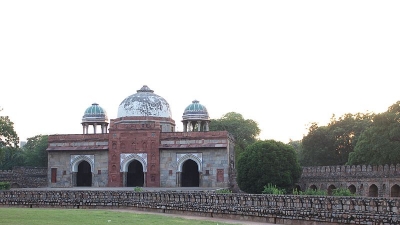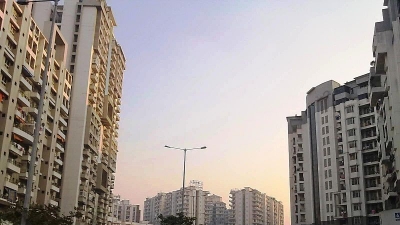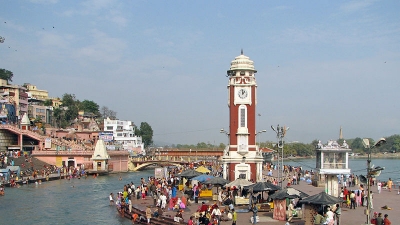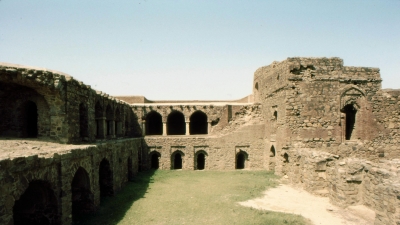Karnal Attractions - Tourist Places To Visit In Karnal
-
01Babur's Mosque
 + Read More
+ Read MoreBabur, the first Mughal emperor of India made several mosques, some original, others by destroying the Hindu temples like the Babri Masjid at Ayodhya. Babur’s Mosque at Karnal, like so many other mosques built in various parts of India, bears the influences of the local as well the Mughal style of architectures.
The construction of the mosque started in 1527 and was completed in 1528. The mosque was constructed by Babur to celebrate his victory over Ibrahim Lodhi and conclusively establish his supremacy over the Indian Empire.
The huge mosque, located over a vast area, had a garden as well, but it has disappeared in the course of time.
The main prayer hall of the mosque measures 53.75x16.5 metres and is covered with a high dome. It had octagonal towers made of bricks and covered by domes, but only one of them has survived until now.
The mosque has three domes. The main dome is flanked by two small domes. The mosque is ringed by two huge walls which are built parallel to each other. It had also a deep well which provided cool and sweet water. A stone tablet in the mosque states in Persian that it was built by an architect Mir Baqi. The mosque is located in the heart of the city of Karnal.
-
02Karna Lake
 + Read More
+ Read MoreKarna Lake, named after Karna, the legendary warrior and donor of Mahabharat fame, is just a 13-15-minute drive from the main city of Karnal. Incidentally, the city itself is also named after Karna.
According to scriptures, the famous warrior used to take bath in this lake known as Karna Tal or pond in those days. It was also at this tal that he donated his famous protective armour to God Indra, the father of Arjun, who was his competitor in strength and a sworn enemy.
Karna Lake is a tourist resort and is not only famous in the district of Karnal but all over Haryana. A special tourist feature of the resort is that it is located right on the edge of the National Highway 1 of the Grand Trunk Road and easily attracts the attention of the cars and the Volvo buses of the tourist department of Haryana driving past it. It, therefore, remains crowded most of the times.
The tree-lined lake and the excellent eateries are surrounded by beautiful landscapes and manicured lawns; the people of the city and the surrounding areas frequently visit it for picnics and parties.
-
03Karnal Fort
 + Read More
+ Read MoreKarnal Fort, also known as Old Fort, has a chequered history. It was built by Gajpat Rai, the ruler of Jind around 1764 AD. Thereafter, it was captured by the Marathas, George Thomas and then by the ruler of Ladwa. Later on it was occupied by the British forces. In the year 1805, it was transferred to Nawab of Karnal.
One year after, it was taken back from him by the British Army for using it a part of the cantonment that was under construction. It was used as a residence for troops, a poor house, a prison and a court after the cantonment was abandoned and shifted to Ambala in 1843 AD, consequent on the outbreak of Malaria.
Subsequently, it became the residence of Dost Mohammad Khan, the ruler of Kabul for a period of six months when he was arrested on his way to Calcutta. Incidentally, his daughter died here and was buried near the bastion on its north-eastern side.
It was again given over to the Nawab of Karnal, but bought back by the British government for Rs 1616. The fort is currently being used as the residence of the Tehsildar and other officials in Karnal.
-
04Gurudwara Manji Sahib
 + Read More
+ Read MoreGurudwara Manji Sahib is situated in the busy Sarafa Bazar in Karnal, about 1 km from the National Highway No.1 of the Grand Trunk Road. According to history, the first guru of the Sikhs, Shri Guru Nanak Devji visited this place in the year 1515 in the course of his first religious journey called Udasi.
He was put up in a garden where he was sitting on a mound and singing hymns or shabads before a large gathering of devotees. In those days, the people of the city of Karnal were under the deep impact of the Muslim pirs or holy men led by the famous pir Abu Ali Shah Kalandar. When they saw a growing crowd of devotees before the Guru, they rushed to the pir with the news of this newcomer.
The kalandar, unfortunately, felt jealous and was incensed on hearing this. He made the wall on which he was sitting to start moving towards the guru in order to impress him with his miraculous powers. But as he drew close to the Guru, the wall stopped moving further. He realized his folly of trying to use miracles to defeat the great saint.
He at once alighted from the wall and walked on to the guru to pay his respects. The all-knowing Guru advised him to desist from using his spiritual powers in useless pedantry and instead work for the welfare of the people. It is believed that the sixth guru of the Sikhs, Guru Harkishan Sahib also visited this spot on his journey to Delhi in 1663.
-
05Christian Cemetery
 + Read More
+ Read MoreThe British set-up exclusive cemeteries across northern India including Karnal to lodge the tombs and monuments of the English men and women including the military commanders, generals, sergeants and the unknown compatriots. The Christian Cemetery, set-up in Karnal in the year 1808, is regarded one of the oldest in the country.
It is situated by the side of the tower in the compound of St James Church, which was dismantled and moved to Ambala to be rebuilt, owing to the shifting of the cantonment from Karnal. It lay near the Government High School on the then plot no. 28 on the way to the police station.
The cemetery hosts the graves of some 50 English men and women. The notable amongst these are the tombs of Captain Robert Morris Bagshaw, Jn Banoman, Drum Major IX Regiment, who died on the 8th January 1809, General Anson, the commander-in-chief and Colonel Hallifax of the 75th Foot, who died on their way to Delhi. The cemetery was surrounded by a masonry wall in 1875. It has been declared a protected monument by the Haryana state government.
-
06Karnal Cantonment Church Tower
 + Read More
+ Read MoreThe Karnal Cantonment Church Tower was a part of St. James church in the cantonment built by the British government, in the year 1805, to meet the challenge of the rising military power of the Sikhs in the region.
Since an epidemic of malaria broke out in the area, the British abandoned the cantonment and shifted it to Ambala in 1843 AD. They dismantled the church to take away its material, but allowed the tower to stay as it had been built out of the subscriptions of the public who objected to its dismantlement.
The massive 35-metre-tall tower is located between the then infantry parade ground and the race course. Topped with an ornamental cross, the tower is an excellent example of the British architecture and is visible as far away as seven miles around it. It has four storeys.
While its first storey is covered with Etruscan plaster, the top storey is plastered with lime. It features semicircular arches in Roman style architecture and a superb panelling artwork. The tower also houses the tablets removed from the church. It is one of the major tourist landmarks in the city.
-
07Pukka Pul
 + Read More
+ Read MorePukka Pul, also called Mughal Bridge is located approximately 7 km from the city of Karnal. It is situated close to what is popularly known as Sayad’s shrine which is made of marble. It hums with public activity, especially on every Thursday of the week. Hordes of folks from the surrounding villages come here to light lamps and make offerings to get their wishes fulfilled.
Some come here to get cured of their complicated diseases, others come to seek prosperity and still others want to exorcise the ghosts from their bodies. The whole atmosphere takes the form of a gala fair where the shopkeepers and vendors have a jolly good time selling their wares, especially materials required for offerings at the shrine.
-
08Durga Bhawani Temple
 + Read More
+ Read MoreDurga Mata or Durga Bhawani is revered by millions of Hindus in India and abroad. Although her devotees have their own perspectives on her depending upon their social and cultural backgrounds, she is universally regarded not only the divine mother of all the human beings, but also of all the gods and goddesses.
To some, she is the eternal companion of Lord Shiva and helps him in critical times in demolishing the evil forces. For example, she helped the gods in killing the demon Mahishassur who had received a boon from Lord Shiva that he could kill any man by putting his hand on his head.
Ma Durga assumed the form of a beautiful woman dancer. She charmed him into putting his own hand over his head and killing himself. It is believed that Ma Durga visits her mother for nine days and departs on the tenth. This is how the festival of Navratre is celebrated for nine days and culminates on the tenth day called Dashmi.
The historic Durga Bhawani temple, situated near the old bus stand in Karnal, is more than one thousand years old. Hordes of devotees visit it to seek her blessings.
-
09Miran Sahib's Tomb
 + Read More
+ Read MoreMiran Sahib, whose full name was Asthan Sayad Mahmud, was a saintly person known far and wide for his humanitarian and charitable work, irrespective of cast, community or religion. According to a story, a Raja abducted a Brahmin girl and refused to release her. Miran Sahib rallied a force of 500 fighters and attacked the raja.
The battle was fiercely fought near the Karnal Railway Station. Although the girl was rescued, almost all the soldiers lost their lives. Miran Sahib also lost a hand in the battle. But the interesting part of the story is that it was buried at a place called Budhana in Patiala district. And when he died in 286 Hijri, his head was buried in Karnal and his body in Jhinjana in the Muzaffarnagar District in Uttar Pradesh.
His tomb was built in the far south of Karnal in a graveyard that also contains the graves of some important members of the Mandal Nawab family of Karnal. There is also a mosque close by.
-
10Karnal Golf Course
 + Read More
+ Read MoreThe game of golf came to India during the British regime since the Englishmen were avid golfers. They set up the first golf course in Calcutta in the year 1829 making India the first country outside Britain to host it. It was called the Royal Calcutta Golf Course and is obviously the oldest golf course in the country.
Later on more golf courses were built in big cities such as Bombay, Bangalore, Shillong, Delhi and many more. With the passage of time, the popularity of the game grew and even smaller cities also started setting up golf courses. They were set up around the lakes, tea estates, forests, deserts and in the cantonments built by the British government.
The topography of Karnal is ideal for setting up golf courses. Consequently, the Haryana Government set up a golf course on the bank of the Western Yamuna canal close to the Oasis complex. The course is so designed that it lies on both sides of the National Highway No.1 of the Grand Trunk Road.
The players have to pass through an underground passage to continue the game. The Karnal Golf Course is set amidst picturesque surroundings close to Karna Lake and Oasis Complex. It has put the city of Karnal on the map of golfing destinations in the country.
-
11Kalandar Shah's Tomb
 + Read More
+ Read MoreKalander Shah’s tomb was built by Ghias-ud-din, Emperor of Delhi in the memory of a Sufi sage named Bo-Ali-Qualander Shah. It is situated just outside Karnal city on its eastern side. The sufi saint was a highly venerated man revered by all communities around the region. His life, miracles and teachings made a deep influence on the minds of the people.
Bo-Ali-Qualander Shah was born in Buddha Khera, a village close to Panipat. According to legend, a faqir or a mendicant visited him along with his pet animal, a ferocious tiger. The idea was to impress Bo-Ali Qalander with his supernatural powers. Miffed by this effrontery, the host produced a cow that gobbled down the tiger.
Still not satisfied with the display of his miraculous powers, he mounted a wall that moved on when he escorted his guest to the bank of a river. There are several other anecdotes about his miraculous powers. He died in 724 Hijri. His tombs were built in Buddha Khera, his native place, Panipat and, of course, in Karnal. The tomb at Karnal is surrounded by a wall. It houses a mosque and fountains.
-
12Ghogripur
 + Read More
+ Read MoreGogripur is a village in Nissing block in Karnal district. It is situated 7 km in the south of Karnal city and is accessible from Bazida Jatan railway station. The village is known for a popular shrine dedicated to a Muslim saint or a pir, Bu-Ali-Kalandar.
The word ‘kalandar’ means a mendicant who neither owns a property not wishes to own one. They are not beggars in the literal sense of the word. They are also called ‘darvesh’ in Urdu. Kalandars are the dearest men of God who survive on whatever is voluntarily offered to them.
They are always intoxicated with the bliss of God and are rarely mindful of their appearance or physical needs. Since they are among the most loved people of God, He never lets them die of starvation.
A kalandar is, therefore, often referred to as Badshah, the King Emperor—a blessed person with nothing to worry about anything in the world and ready to give the most invaluable gifts to the people around them.
Kalandars are blessed with divine powers which can heal the gravest of diseases and transform paupers into kings. They can perform unbelievable miracles ,but they do not do anything for their own benefit. Village Gogripur is the proud habitat to the mausoleum of one such kalandar. People flock to his mausoleum to offer prayers and seek his blessings for the fulfilment of their desires.
-
13Minars
 + Read More
+ Read MoreAlso called kos minars or mile pillars, minars have been used to denote a distance of one mile on the roads for centuries in India. One kos is equal to 1.1 mile or 3.2 km. They were first built by Sher Shah Suri, the Afghan ruler. The tradition was picked up by the Mughal rulers on the important roads across the length and width of the country.
The rulers used the minars not only to measure the distance, but also provide shelter to the tired travellers. These minars were strong circular structures that stood 30 ft tall on platforms made of bricks or stone and covered with lime plasters. The minars, moreover, also helped in maintaining communication system in the vast empire.
The modus operandi was to transmit a message from person to person until it reached the destination. Sometimes small lodges or sarais were also built along the minars for travellers to rest overnight. Some of these minars were built along the GT road starting from Lahore and running through Karnal over to Delhi.
One of these was located close to plot no.79 in Karnal. One of the sarais was built on Gharaunda about 12 miles in the south of the city.
-
14Dargah Nuri
 + Read More
+ Read MoreThe word ‘dargah’ owes its origin to Persian language. It means a mausoleum or the shrine built over the graves of the revered Muslim Sufi saints and sages also called ‘darvesh’, mendicant or ‘murshid’ meaning spiritual teacher. The Muslims visit these holy places as a part of their pilgrimage (ziyarat) to earn religious merit and peace of mind.
They also visit them on special days for prayers. The dargah normally includes a mosque for prayers and a madarssa - religious school - for the students. It also houses the residences of the teachers, caretakers, maulvis, meeting rooms for the Sufi sages, a dispensary and other buildings for the community.
Another purpose for erecting the durgah is the belief that the spirits of the departed Sufi sages can be invoked for guidance and blessings. The dargahs also host musical recitations called qawalis and kifis in praise of the departed saints and also Allah.
Some of the prominent singers of Sufi music are Nusrat Fateh Ali Khan and Abida Parveen of Pakistan. One such dargah called Dargah Nuri is situated at village Newal on the Karnal-Kunjpura road. It was built in the memory of Hazrat Sufi Shah Alama Nur Mohd. of Delhi.
-
15Naraina
 + Read More
+ Read MoreLocated 11 km from the city of Karnal and 5 km from Taroari, its satellite town, Naraina holds an important place in the history of India. It was at Taraori that Shahab-ud-din Muhammad Ghuri, also known as Mohd Bin Sam was defeated by Prithvi Raj Chauhan, the ruler of Delhi in 1191 A.D. He, however, returned the next year.
First, he lured the Rajput with a promise of truce so that they became complacent. Then he took advantage of their normal battle routine. The Rajput soldiers rose at 3 am in the morning, performed the ablutions, took bath and had breakfast. They then took up their weapons and appeared for battle with the Muslim forces before sunrise.
Mohammad Ghuri knew this practice and, therefore, he launched an attack right when the Rajput army was occupied with the morning ablutions. They had empty stomachs and no arms. Rest, as they say, is history.



 Click it and Unblock the Notifications
Click it and Unblock the Notifications





